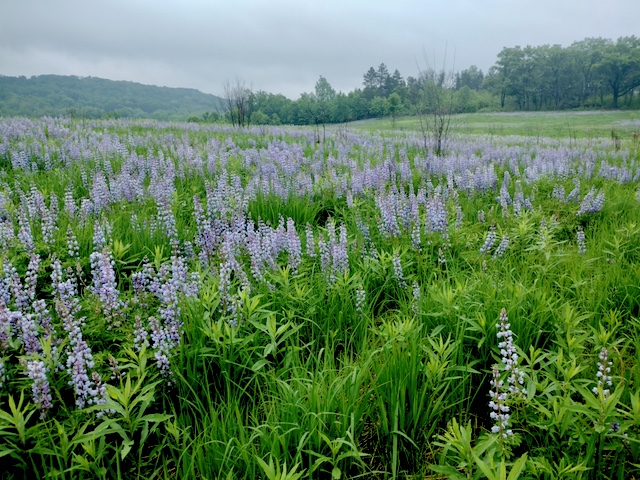Abundance

The goldfinch emerges from the gloom of the Baraboo Range, flaring out as it comes to rest on the feeder. This May morning it is joined briefly by a riot of feathered neighbors converging on the feeder for a quick meal during the lull between showers. Thunder and lightning warn the interlude is likely to be short and prompt action is necessary to avoid being caught out when the rain returns. And return it does. In the next moment rain spatters the roof of the feeder now abandoned by all but the most intrepid winged neighbors.
Spring arrived early on the Baraboo Range and settled in to the serious work of bringing life to the hills. Abundant moisture and moderately warm temperatures brought a gradual but determined emergence of life.
As the snows retreated so early that prescribed burn crews were lighting rejuvenating low intensity fires even as wildfire crews from the DNR were being called out to suppress destructive wildland blazes in late February. Wildfire is extremely rare on the Baraboo Range. A half century of intense invasion by determined shrubs, coupled with benign neglect has created thousands of acres of asbestos woodland resistant to fire but nearly as devoid of diversity. Scattered throughout this landscape, determined landowners apply wise stewardship creating a mosaic prairie openings, pockets of savanna and hopeful woodlands that together nurture a resurgence of plant and wildlife diversity.
Providing absolute proof of the proper and orderly return of spring in the hills was the brief but abundant flush of flush of morel mushrooms that burst into life in numbers that we have not seen at the Squirrel Farm in our brief five year tenure. Two days saw their appearance and departure. both half morels and their regal cousins the true morel. Their profusion the most undeniable testament to an orderly beginning to bountiful growing season. In Wisconsin, we understand this fungi as the harbinger of a successful year in the outdoors.
And choreographing this perfect spring has been the sunshine and the rain. Both trading lead and follow like an exquisite couple of ballroom dancers. Several days of showers, ranging from light drizzle to intense downpours ensure the earth has sufficient time to capture and store the bounty. In between a week or more of glorious sunshine drives life from the earth.
In the riverine sand plain beneath the hills, lupine explode in a profusion of purple, blue and white. Carpets of color paint the rolling tall grass prairies of the Riverland Conservancy with impressionist beauty rivaling any 19th century French masterpiece. The promise it offers for delights to come leaves the mind in wild imagining.
Further upslope, the woodlands and their edges display similar abundance, if in a somewhat more understated manner. Flower dogwood, maple leaf viburnum, serviceberry and high bush cranberry throw splashes of brilliant white through the mid-story while black cherry trees illuminate the woodland canopy like a thousand torches. Shagbark hickory make their own distinctive display as their leaf buds erupt, springing to life with elan. The white oaks, having been spared a difficult winter, are making giant strides for the sky wherever holes in the canopy provide sufficient sunlight. Hackberry, elm, wood geranium and Jack-in-the-pulpet form a woodland chorus every bit as rich as any cathedral choir.
As the clouds lighten and the rain subsides, hummingbirds emerge to service the beckoning blossoms and the bird feeder is once again a hub of intense traffic. The splendor of the Baraboo Hills this spring holds extraordinary promise for a year of beauty and wonder across Wisconsin.
